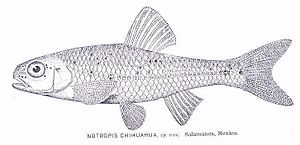Chihuahua shiner facts for kids
Quick facts for kids Chihuahua shiner |
|
|---|---|
 |
|
| Conservation status | |
| Scientific classification |
The Chihuahua shiner (Notropis chihuahua) is a type of small, freshwater fish. It belongs to the minnow family, called Cyprinidae. You can find this fish in rivers and streams in southern Texas and northern Mexico.
Contents
What Does It Look Like?
The Chihuahua shiner has a strong, slightly flattened body. Its deepest part is just behind its head. Its mouth is flat and sits under a rounded snout.
This fish has a full lateral line, which is a special sensing organ along its side. Its back fin (called the dorsal fin) usually has fewer than 10 rays. The longest ray is twice as long as the last one. The dorsal fin starts right above the belly fin (the pelvic fin). The fin on its underside near the tail (the anal fin) has 7 soft rays.
The lower lip of the Chihuahua shiner is thin and smooth. Its lateral line has 33 to 37 scales and is usually straight.
When male fish are ready to breed, they grow small bumps called tubercles. These bumps are less noticeable in non-breeding males and are not found on females.
The fish's back is straw yellow with many large black spots. These spots are also on its gill cover (the opercle), under its eye, and on the sides of its snout. There's a black wedge shape near its tail. The pores of the lateral line at the front are outlined in black. Its lips are yellow to light orange, and its dorsal, tail, and chest fins (the pectoral fins) are also yellow or light orange.
Often, you can see a dark stripe along its back. Another stripe runs along its silvery side, starting dark near the head and becoming black towards the tail. Its belly is white, and its internal lining (the peritoneum) is silvery.
This fish can grow up to 64 millimeters (about 2.5 inches) long, measured from its snout to the base of its tail. Its total length, including the tail, can be about 8 centimeters (about 3 inches).
Where Does It Live?
The Chihuahua shiner lives in the Rio Grande river system. You can find it from near the mouth of the Rio Grande up to where the Rio Conchos and lower Pecos River join it in Texas.
It also lives in smaller rivers that flow into the Rio Conchos in the Mexican states of Chihuahua and Durango. In these areas, it is quite common.
Its Home and Lifestyle
The Chihuahua shiner prefers small to medium-sized streams. It likes clear, cool, flowing water with bottoms made of gravel or sand. Sometimes, it can also be found over rocky bottoms with some boulders, bedrock, and mud. It might even live where there are plants in the water. The places where these fish are found often have natural springs nearby.
These fish have a long breeding season, which lasts from March all the way through early August. Female fish can have between 400 and 900 mature eggs in their bodies. Usually, there are more males than females in a group. For every female, there might be 1.3 to 1.6 males.
Scientists have looked at what these fish eat by checking their stomach contents. They found that Chihuahua shiners mostly eat small insects that live in the water. They are known to live for up to two years.
Protecting the Chihuahua Shiner
The Chihuahua shiner faces some challenges. One big threat is that the water in the small creeks where they breed and raise their young is drying up. This makes it hard for them to have baby fish.
Another problem is the introduction of new fish species that are not native to the area. These new fish might compete with the Chihuahua shiner for food and space, or they might even eat the shiners. Protecting their habitats and managing water resources are important steps to help these fish survive.
See also
 In Spanish: Notropis chihuahua para niños
In Spanish: Notropis chihuahua para niños


